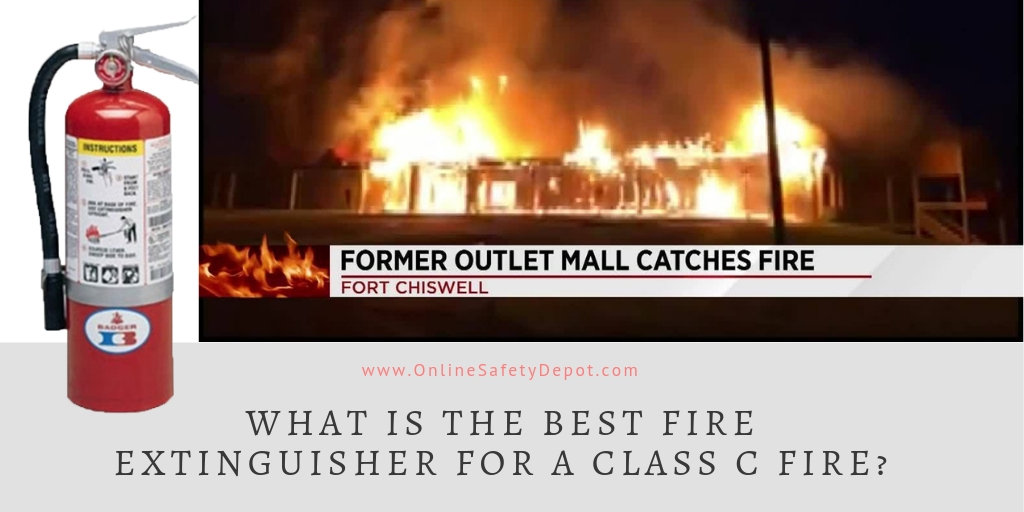What is the best fire extinguisher for a Class C fire?
Energized Electrical fires are categorized as Class C fires. This means that the fire is fueled by electricity. Once the Electricity is removed or shut off, the fire is no longer classified as a Class C fire.
What is the best fire extinguisher for a Class C fire? For fires that involve sensitive equipment such as computers, servers, data centers, or other electrical equipment, Carbon Dioxide and Halotron Fire extinguishers are the best options to extinguish the fire without damaging the sensitive equipment. If the electrical fire doesn’t involve sensitive equipment, then an ABC or Standard BC fire extinguisher will extinguish Class C fire.
Each type of fire extinguisher on the market today use a different agent to effectively extinguish the fire. Review the chart below to see the different fire extinguishers and the agent used in them.
| Extinguisher Type | Agent Used | Agent Type |
| ABC Class Fire Extinguishers | Dry Chemical Monoammonium Phosphate | Dry Chemical |
| Standard BC Fire Extinguishers | sodium bicarbonate-based agent | Dry Chemical |
| Halotron Fire Extinguishers | Halotron I | Clean Agent |
| Carbon Dioxide Fire Extinguishers | Carbon Dioxide (Pressured Gas) | Clean Agent |
As mentioned above, not all Class C fires are the same. Fires that involve sensitive electrical equipment need to be extinguished by a clean agent fire extinguisher otherwise the Dry Chemical, Monoammonium Phosphate or sodium bicarbonate may damage the electrical equipment due to its corrosive and damaging properties on electrical equipment.
Dry Chemical vs Clean Agent
Dry Chemical: Fire extinguishers such as the ABC Class fire extinguisher or the Standard BC Class fire extinguishers use a light, fine solid powder that extinguishes the fire. While the ABC Class fire extinguisher is effective in fighting Class A, Class B, and Class C fires, the dry chemical powder needs to be cleaned up after it has been discharged.
Clean Agent: The Halotron I and the Carbon Dioxide fire extinguishers are known as “clean agent” fire extinguishers. Agents used in these fire extinguishers are residue-free and easy to clean up after it has been discharged. The Halotron fire extinguishers are designed to extinguish Class A, Class B, and Class C fires while the Carbon Dioxide Fire extinguishers are only designed to extinguish Class B and Class C fires.
Portable vs Wheeled Class C Fire Extinguishers
Fire extinguishers are available in both portable and wheeled fire extinguishers. The location, size, and environment in which the fire extinguisher will be used will be the determining factor as to which model type you choose.
Portable Fire Extinguishers: Portable fire extinguishers are designed to extinguish smaller fires and are the most common model type as they are easy to use and take up little space. Portable fire extinguishers are found in both public and private settings such as offices, homes, stores, and malls.
Potable fire extinguishers are available in the following design types: ABC Class, BC Class, Carbon Dioxide and Halotron I.
Wheeled Fire Extinguishers: Wheeled fire extinguishers are much larger, typically between 50 pounds to 350 pounds which allow them to extinguish larger fires. Due to its larger design and extinguishing capabilities, wheeled fire extinguishers are typically found in the following places: cruise liners, warehouses, data centers, boat docks, oil rigs, and airports.
Wheeled fire extinguishers are available in the following design types: ABC Class, BC Class, Carbon Dioxide and Halotron I.
Related Questions:
For sensitive equipment, is the Halotron I or Carbon Dioxide fire extinguisher better?
It’s difficult to say which of the two fire extinguishers is better without knowing the environment in which it will be used.
However, it is important to note that the halotron fire extinguishers are capable of extinguishing Class A, Class B, and Class C fires. Whereas the Carbon Dioxide fire extinguisher is only capable of extinguishing Class B and Class C fires.
If there is a chance that a Class A fire may occur in the office or building where the fire extinguisher will be used, it is better to get the Halotron fire extinguisher.
Are wheeled fire extinguishers moveable or portable?
Yes- Wheeled fire extinguishers are designed with large wheels and well-balanced frames which allows the unit to be transported and moved by a single person. However, it is not as easy to move as a “portable” fire extinguisher.
Can Dry Chemical fire extinguishers be used in the home with kids or pets?
The most popular fire extinguisher in homes across the United States is the ABC Class fire extinguisher, which is a dry chemical fire extinguisher, due to its ability to extinguish Class AB and C fires that are common in homes. Each brand and manufacture publish the Material Safety Data Sheets (MSDS) for each on the fire extinguishers, agents and other related products made by that respective company. You can Click HERE to review the MSDS for the ABC Class, BC Class, Carbon Dioxide and Halotron fire extinguishers.
Can Water be used on a Class C fire in the Kitchen?
Water should never be used on any Class C fires. Water conducts electricity which can make the fire worse by acting like a source of ignition for the fire.
If you don’t have access to a fire extinguisher that can extinguish a Class C fire. Shut off the power to the house so that there is no more electricity fueling the fire, then you may use water to extinguish the fire.
WARNING: You must be 100% sure that there is no more power in the immediate area. If there is still power, the results of throwing water onto the fire/power source may prove fatal.

